If you’re looking for innovative garage solutions that are not only unique but also practical, then consider some ideas from shipping container garage.
On the whole, not long ago, shipping containers were solely used for transportation of cargo and storage units. Today we see many types of buildings and structures being built using only shipping containers. This number is likely to increase in the future.
But not all structures are suitable for building out of shipping containers. Container garages are one of the most popular types of shipping container structures.
To point out, there are plenty of reasons why shipping containers make excellent garages. That’s why we see more and more of them every day.
And so this article will focus on the greatest shipping container garage examples, ideas, and why shipping container garages are essential.
We will delve into the concept of shipping container garages, highlighting their advantages and benefits, including cost-effectiveness, durability, and customization options.
So, whether you’re considering a new garage or looking to repurpose a shipping container, let’s explore the endless possibilities and ideas offered by this architectural trend.
Table of Contents
Definition and Concept of Shipping Container Garages
To explain, shipping container garages refer to repurposing cargo containers into functional garage spaces.
These containers, originally designed for shipping different cargo and goods, offer a robust foundation that can be transformed into a reliable structure.
What’s more, you can then use them to protect your vehicles, equipment, or create an additional storage unit.
Read More: How To Get Permits For Container Homes In Florida
Brief Overview of the Content Plan
In the upcoming sections, we will guide you through various shipping container garage ideas to inspire your own project.
From creative design concepts and clever storage solutions to efficient organization tips and smart security features, our comprehensive content plan will cover everything you need to know to create the perfect shipping container garage that combines functionality and style.
Advantages and Benefits of Using Shipping Containers for Garages
1. Cost-effectiveness
One of the major advantages of using shipping containers for garages is their affordability. Compared to traditional construction methods, repurposing a shipping container can save you a significant amount of money and create extra floor space.
Also, containers are readily available in the market, offering a cost-effective solution that doesn’t compromise on quality.
If you’ve been shopping around, you’ll notice that shipping containers are cheap and affordable, especially with traditional building materials like lumber and concrete blocks.
This means you can save money on construction costs while still getting the same functionality out of your new garage as if you had built it with traditional materials.
Made from three 20-foot used shipping containers, a DIY version of this structure could cost $6,000 for the containers, and another $1,500 for a garage door.
On the other hand, a similar-sized steel building kit would run around $5,500. The price tag includes everything needed to build an entire pre-fabricated home but does not include foundation installation costs that may come on top of it.
Read More: How Much Does A Used Shipping Container Cost? Expert Guide
2. Durability and Strength
Constructed to withstand extreme weather conditions and heavy loads, shipping containers are built to last.
Made from weathering steel, also known as Corten steel, these containers are highly durable and resistant to corrosion. As such, they will ensure that you have a reliable and long-lasting garage solution.
3. Versatility and Customization Options
Shipping containers provide incredible versatility when it comes to customization. These containers offer a blank canvas, tabula rasa kind of, allowing you to design your garage according to your specific needs and preferences.
From adding windows and doors to incorporating insulation and electrical systems, you have the freedom to adapt the space to suit your requirements.
The shipping container garage is fully customizable as we’ve pointed out. You can use it to house different things, from a workshop to a pool shed or even a studio apartment. The possibilities are endless!
Most important, a shipping container garage has many similarities to a regular garage. They both have the same essential components, including doors and windows, which makes them easy to convert into whatever you need them to be.
What’s more, it can be as straightforward or as complex as you want it to be, and the list of what you can do with it is endless. Your imagination is the only limit when designing your shipping container garage!
Read More: 20 Best Interior Design Ideas For Beautiful Shipping Container Homes
4. Privacy of Shipping Container Garages
The shipping container garage ideas that you’ll find in this article, will provide excellent privacy. And so this is why it is a great choice for the backyard.
You can build a container garage at the back of your home and use it as an extra storage space or even for office purposes.
This way, you can enjoy the view of your beautiful garden from inside your garage. It also helps you from misplacing your tools or causing accidental injuries.
5. Shipping Container Garage Security
Without a doubt, shipping container garages also offer security because of their durability and strength. Shipping containers have sturdy steel frames, which make them difficult to break into.
So if someone tries to break in, they’ll find themselves facing an intimidating obstacle that will deter them from trying again later on down the road when they think nobody is watching!
6. Ideal Storage Option
Shipping containers have a wide range of uses. They are the ideal solution for storing goods, especially in remote locations where there is no other viable storage option.
You can stack the shipping containers on top of each other to save space. They also come with an insulated roof that protects against the elements and helps keep everything inside dry and cool in your garage.
Adding more equipment and tools can also easily convert your garage into a workshop. This way, you’ll get more out of your investment!
Read More: Seven Helpful Ideas for Designing A Container Home Bedroom
7. Shipping Container Garage Portability
One of the best features and ideas of a shipping container garage is its portability. You can move them from place to place and is easy to store when not in use.
This makes it a brilliant option for those looking for an affordable alternative to building a traditional garage.
8. Fast to Construct Shipping Container Garage Ideas
Shipping containers are pre-fabricated and designed to be stacked, making them easy to put together. Once you have purchased your container, you can have it assembled in as little as two weeks.
The duration will vary depending on the project’s complexity, but in general, this is one of the fastest ways to build a new structure on your property.
Read More: 7 Shipping Container Home Foundation Ideas: Ultimate Guide
Container Garage Ideas with Two Double Car Garage Doors
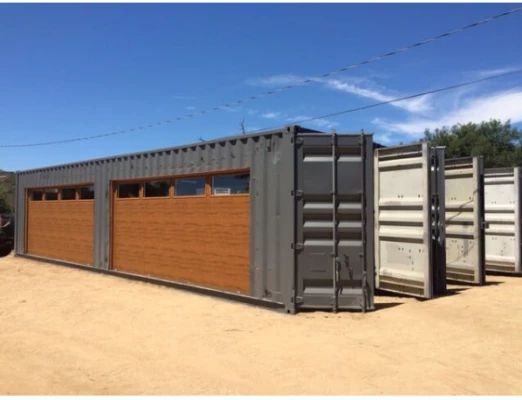
These type of design ideas are usually common for container garages, although the units are larger than usual. There are three adjacent 40-foot containers forming a floor area of 120 square feet.
Two 16-foot wide garage doors are installed in a container’s sidewall, while the others have their internal walls removed.
You can effectively cut the original design in half by using three 20-foot containers with a single 16-foot door. This would make a garage 20 feet by 24 feet, a perfect size for most vehicles!
Read More: 15 Best Container Homes You Can Own Under $100K
A Shipping Container Garage Connected to a Shipping Container Home
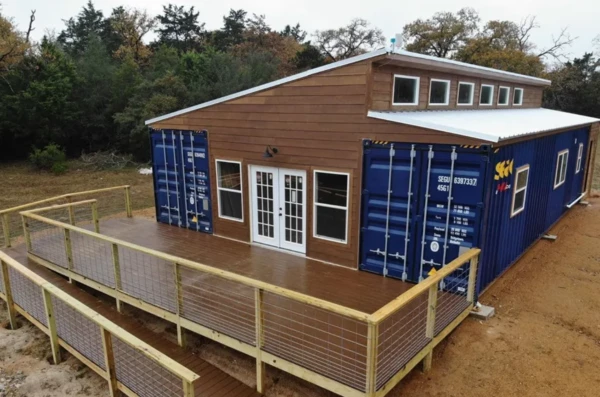
This shipping container garage is interesting because of the connection to a traditional home in the same way that most garages are. The company places and covers two shipping containers with a custom roof to add more space.
The wall of one container will be removed to combine it vertically with the other unit. This will create multi-room living spaces for residents.
The transformation of their shipping container into a home involves keeping one wall intact, making the other side a garage that is accessible from the inside.
They also built a fantastic deck that spans the entire width of the container. This stunning creation is a design of Back Country Containers based in Texas.
Open Space Shipping Container Garage Ideas
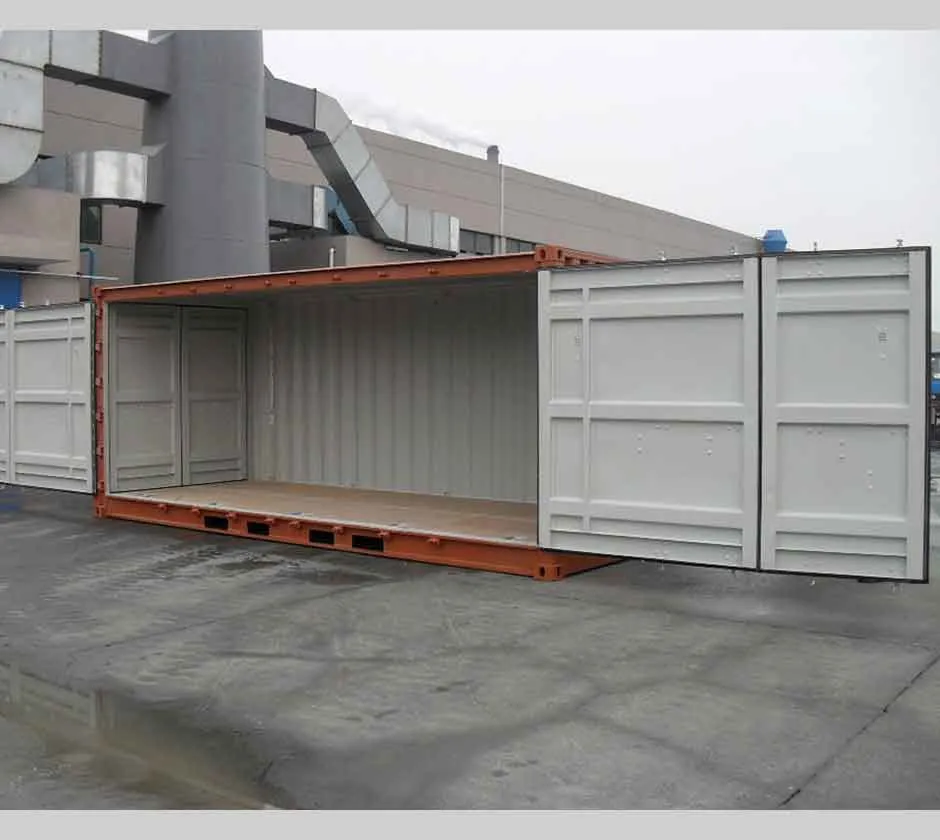
A garage is not always intended to be locked. In some cases, it’s meant only to protect a car from the elements, in which case an open-air rooftop will suffice.
There are several designs for organizing a garage, but one of the most popular is made by two chipping containers set up at both ends with the main space between them.
You can stack the containers and join them together by a roof. This allows you to exploit the space inside them as storage and the area under the container stack as parking lots.
Due to the containers’ modular dimensions, You can store vehicles within them if necessary and still leave plenty of room for other uses.
Read More: Amazing Truth About Container Homes In Ohio And Their Legality
Single Container Workshop
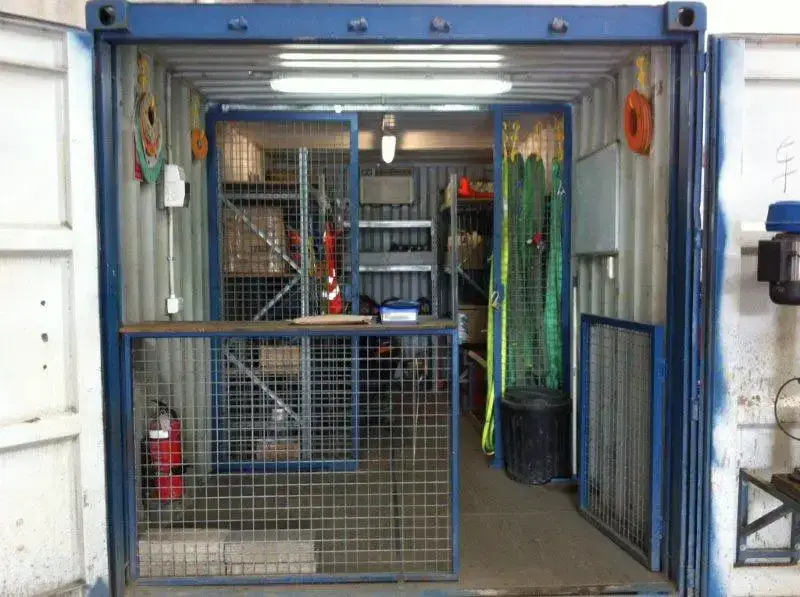
This is one 40-foot container full of storage and tools but arranged for ease of use. This container would indeed be too small to rebuild a car in, but if you were planning on using it for less ambitious projects, the size might work well.
If you have a larger project, it’s best to open the doors and work on it outside. Then put all your tools away in your secure container shop at night when you finish your work.
A further benefit of this design is that you can transport all your tools and supplies easily to a different location on your property or miles away from home.
Luxury Container Garage
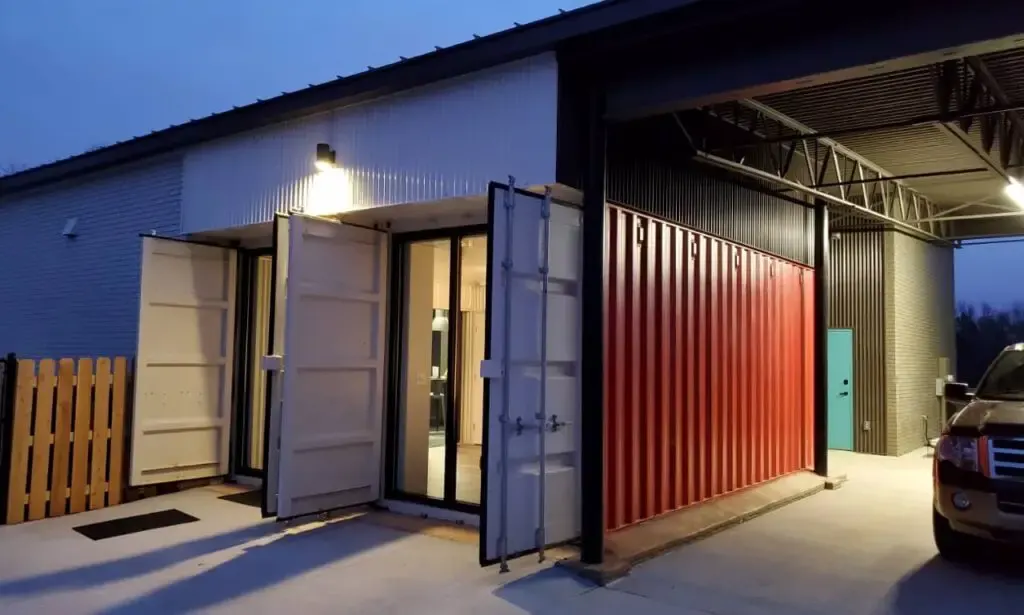
This design for a container dream garage is quite similar to the Two Double Car Garage Doors concept, with a few key differences. It uses five 40 ft high-cube containers placed side-by-side to create an expansive space 40ft by 40ft.
The garage is much deeper than the average one and should allow you to park two cars in each of its three bays for six vehicles.
Three 8.5ft wide doors in front make it the perfect place to store owner’s expensive cars, unlike our previous garage that had four car widths and could only hold two vehicles at a time. You can open the doors of multiple cars at once, walk around them and still have room to work.
One unique feature of the home is its interior paint job with a horizontal stripe that touches every wall. This provides unity between all five rooms and makes them seem like one larger space while adding liveliness to an otherwise muted color palette.
The container’s relatively modest exterior does not indicate the valuable contents it holds.
Read More: 7 Clever Uses of Shipping Containers
Single Container Motorcycle Maintenance Shop
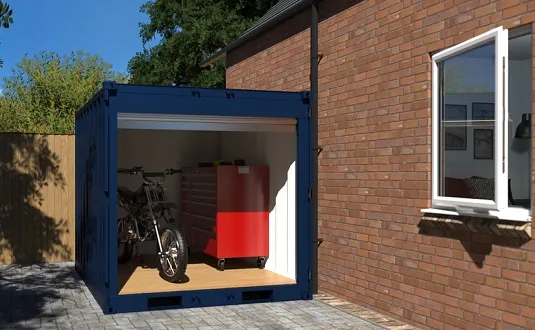
Evidently, this conversion is somewhere between a workshop and a man cave, with enough space to do all the normal preventative maintenance work for a motorcycle and relax with friends. It’s precisely the dream garage people can’t wait to show off!
The diamond-plate aluminum floor, Harley Davidson interior paint scheme, and other branded accessories give this space a cohesive design theme. And the director’s chairs, stereo, and mini fridge let you know that it’s available for work or play.
Whether or not you enjoy motorcycles, it’s easy to see how a simple 20 ft storage container shop like this could be the perfect place for any personal hobby. Employing some basic interior design ideas makes the space stand out.
Shipping Container with Car Port
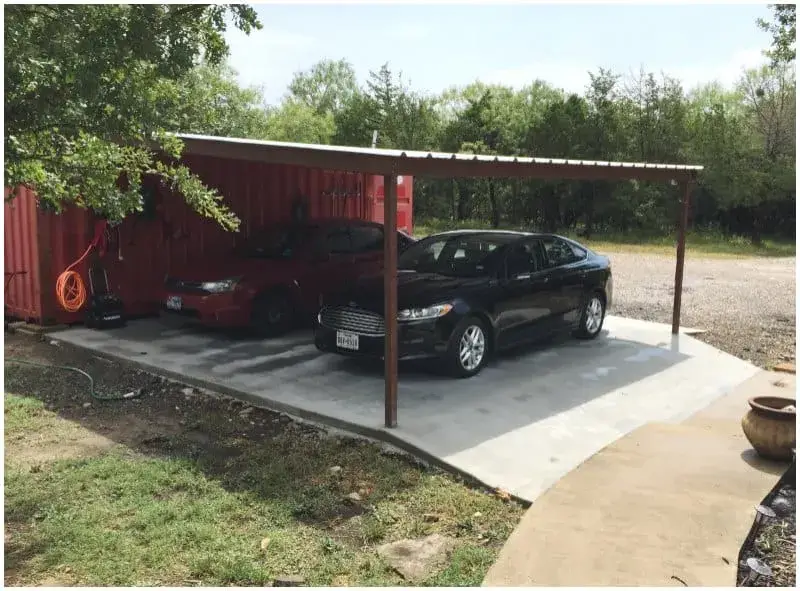
If you live in a temperate part of the country and want to protect your vehicle from the sun, an excellent option is this design: blocking out sunlight with a 40-foot shipping container.
The Texas couple bought a shipping container for $2,900, then spent an additional $200 on a solar fan to keep the garage cool.
They were aware that they wanted their container slightly off the ground to include an incline ramp for their motorcycle, so this design feature was intentional.
So they bought a few concrete blocks and installed a simple ramp. It’s an uncomplicated design that works well for the family’s needs.
Read More: Shipping Container Homes In Texas: How To Build One
Container Cover Garage
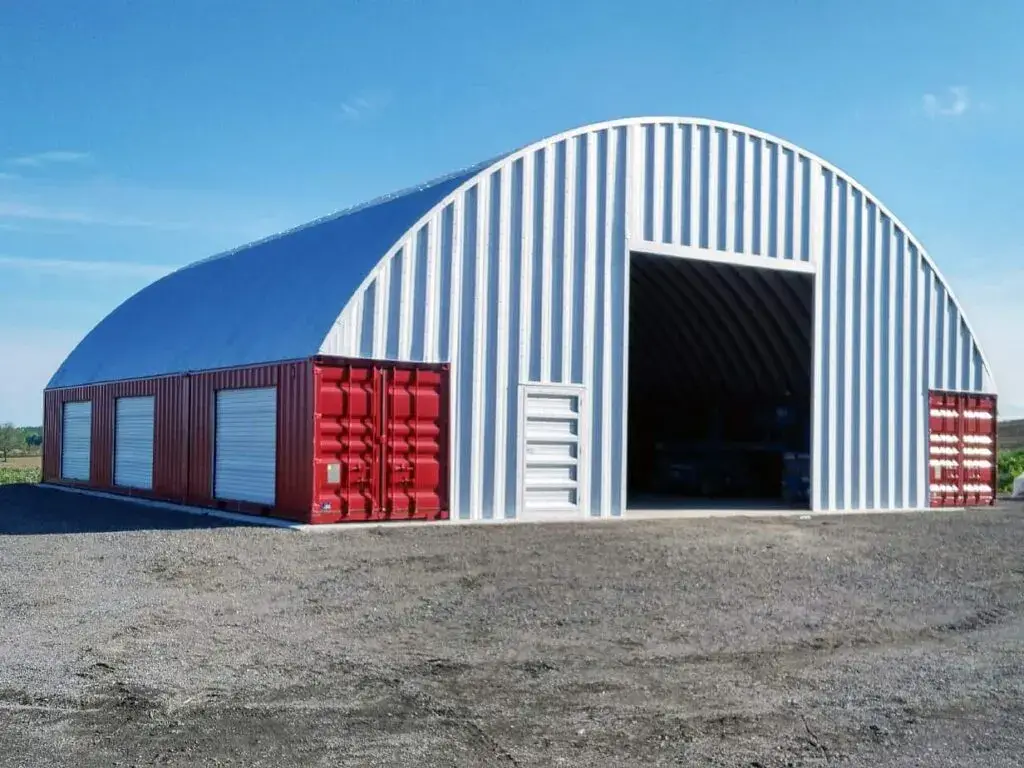
By all means, this is a unique option for those who want to create an additional living space in their container home.
The container cover garage involves building a metal frame over the opening between two parallel shipping containers that makes one large room.
The forms and dimensions of that roof can vary wildly, depending on the individual. Some people design their own by building a wooden-framed “roof” over the gap between containers at about 20 ft in height, without using trusses or laminated beams.
Note that one option is a corrugated metal arch created with the specific intent of working as an aquaponics greenhouse.
You can also use tensioned fabric awnings above metal structures, which are lighter and more temporary than traditional roofs. Still, most people rely on engineered wood or metal trusses with their traditional roofing system.
There are several types of garages made from shipping containers, but in each case, the walls formed by these containers make up only part of the roofed structure.
Container Garage with Overhead Door in the End
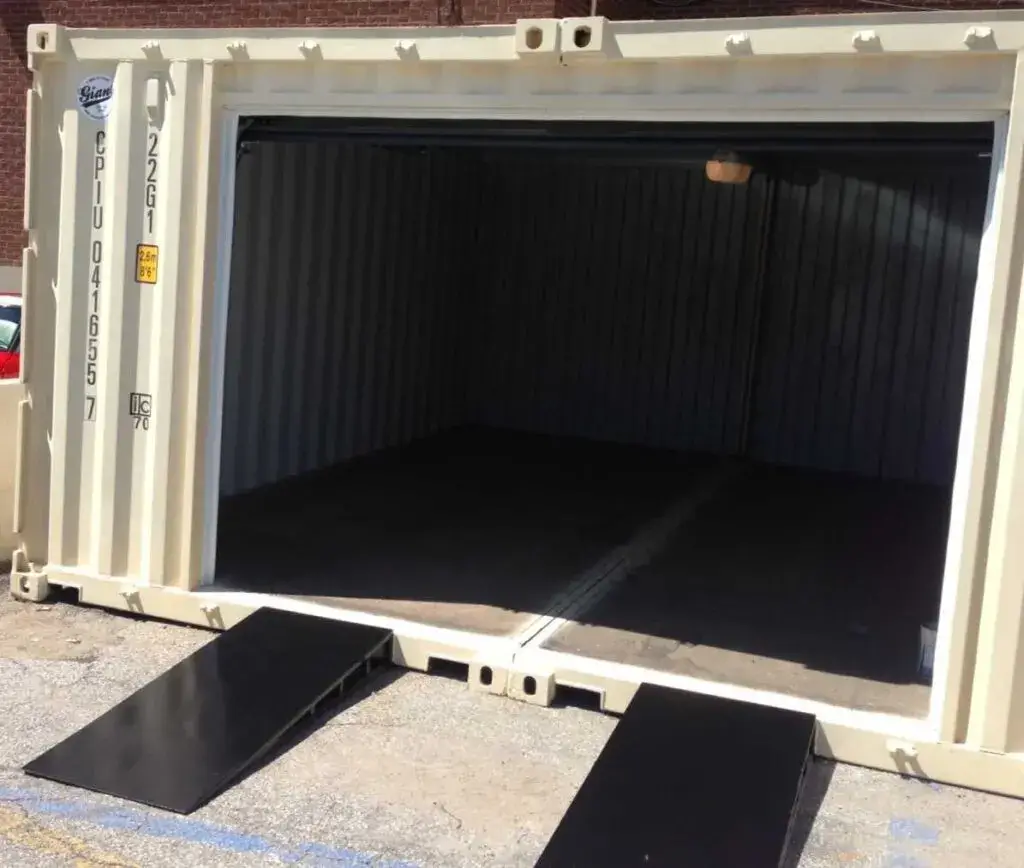
As can be seen in the photo, adding an overhead door to one of the container’s long sides is typically how you construct a garage from two shipping containers.
This is because eight feet of width, the minimum required for most vehicles, is not enough if you want to put two containers side by side; placing them in corner structures would impede your ability to open both doors simultaneously.
On these ideas of shipping container garage, you can overcome this structural challenge of the overhead door by removing vertical members from two 20 ft containers to create a wider entrance.
But as usual, have chat with a structural engineer in case you plan to stack more containers on top of each other to avoid damage and failure of your structure.
This modification is very complex, as it substantially alters the structure of both containers. To accommodate this change, the two containers need attachment at the corners, and ideally, a large beam as a door header.
The overhead garage door is installed at the end of containers originally fitted with swing doors. All those doors will be removed, and additional corrugated sheet metal will be added to strengthen the walls.
This new metal slightly reduces the horizontal size of the opening for the garage door where swinging doors previously opened.
This two-container garage results in a 16 ft wide by 20 ft deep space that gives plenty of room for maneuvering around and parking even large vehicles.
Garage Ideas From Open-Sided Shipping Container
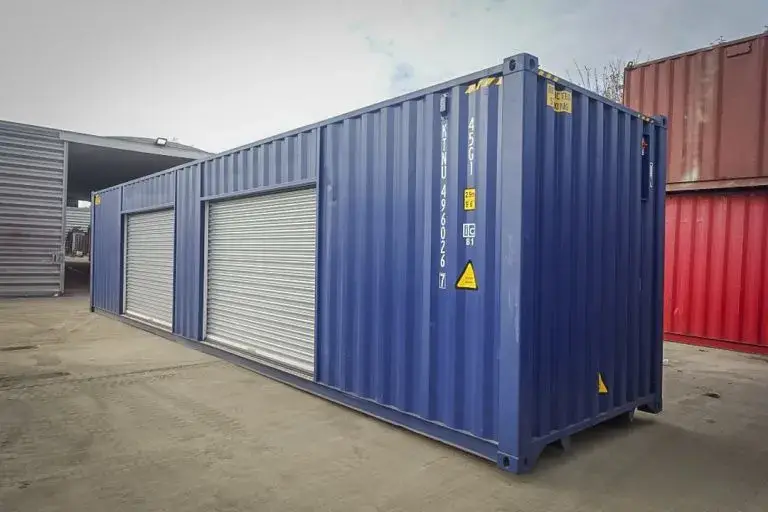
This garage is more of a concept than an example since no one has ever attempted it. In short, instead of cutting an overhead door into the side of containers, you could use an open-sided container as the front section and then cover it up to act as the front door of the garage.
Open-sided containers can have two bifold doors, which may then be opened to expose the entire long side of the container.
The only open-sided container available in the 20ft size is usually suited for shipping purposes. But combining that with two standard containers is a perfect solution for entering your garage.
You still have to remove the walls inside shipping containers when converting them into a garage, but you don’t need to worry about adding an overhead door.
The main drawback to this idea is the cost. Open-sided containers typically cost about twice as much per unit of volume compared with regular containers.
It is rarer and more expensive to build a garage in this way, but for someone who wants one of the highest-quality garages available today, it can be worth considering.
Read More: The History of Shipping Containers
Ideas for Choosing the Right Shipping Container for Your Garage
A. Evaluating Container Sizes and Dimensions
When it comes to choosing a shipping container for your garage project, size and dimensions play a crucial role.
And so for obvious reasons, you need to carefully assess the available space on your property and determine how many vehicles or items you plan to store in the garage.
Shipping containers come in various sizes, including:
- 10-foot containers.
- 20-foot containers.
- 40-foot containers.
- And even larger sizes for extra space.
Therefore, consider the length, width, and height of the container to ensure it can accommodate your vehicles and allow for easy movement within the garage.
Read More: 8 Of The Best Shipping Container Pools In Texas Builders
B. Assessing Container Conditions and Quality
Before purchasing a cargo container, it’s essential to assess its condition and quality. Some containers may have undergone extensive wear and tear during their transportation journeys.
Furthermore, look out for any signs of rust, dents, or structural damage that could compromise the integrity of the container. Inspect the doors and locks to ensure they are functioning properly.
C. Selecting the Appropriate Container for Your Garage Project
Choosing the appropriate container for your garage requires considering both the size and condition, as well as your specific project requirements.
If you plan to make extensive modifications to the container, such as adding windows or extra doors, it’s advisable to choose a container in better condition and with a stronger structure. Alternatively, if you only need basic modifications, a container in average condition might be sufficient.
Additionally, consider the material of the container. While most shipping containers are made of steel, there are some options available with specialized coatings for added durability and protection against the elements.
Note that some containers, like refers or refrigerated containers are made out of aluminum and they come insulated. They are a bit pricey compared to other regular or standard sea containers, and so they are hardly used in building.
Designing a Shipping Container Garage
A. Exploring Different Garage Designs Using Shipping Containers
When it comes to designing a shipping container garage, the possibilities are endless. We touched briefly on this earlier, but here are a few more popular designs:
- Single-container garage: As the name suggests, this design incorporates a single shipping container as the main structure of the garage. It provides a compact and cost-effective solution for those with limited space.
- Multi-container garage: For those needing more space, a multi-container garage is a great option. By connecting two or more containers side by side or stacking them, you can create a larger garage.
- Hybrid designs with traditional building materials: Some individuals prefer to combine shipping containers with traditional building materials such as wood or bricks. This allows for a more customized and unique garage design.
B. Creative Storage Solutions with Shipping Containers
Shipping containers are not only great for storage, but they also offer creative solutions for organizing and maximizing space inside your garage:
1. Utilizing Vertical Space
Generally, with the help of sturdy shelves and racks, you can take advantage of the vertical space within the container. This allows for efficient storage of tools, equipment, and other items.
2. Customizing Shelves and Racks
In case you didn’t know, note that shipping containers can be easily modified to include custom shelves and racks. This ensures that your garage is tailored to your specific storage needs.
3. Incorporating Modular Storage Units
Emphatically, modular storage units can be installed to provide flexibility and ease of organization. These units can be easily attached to the container walls, creating a versatile storage solution.
4. Transforming a Shipping Container into a Garage
Transforming a shipping container into a functional garage requires careful planning and execution. Consider the following factors:
- Structural modifications to accommodate doors, windows, and ventilation.
- Proper insulation to regulate temperature and protect items stored inside.
- Electrical wiring and lighting fixtures for convenience and safety.
5. Interior and Exterior Modifications for Shipping Container Garages
Customizing the interior and exterior of your shipping container garage can help create a space that is both functional and aesthetically pleasing. Consider these modifications:
- Painting the container’s exterior to match your home or personal style.
- Adding windows for natural light and ventilation.
- Installing a roll-up or sectional garage door for easy access.
6. Insulation and Climate Control Options for Shipping Container Garages
By all means, a cargo container can get really hot or cold when not properly insulated. To ensure the comfort and protection of your belongings, it’s important to consider insulation and climate control options:
- Insulating the interior walls and ceiling to regulate temperature.
- Installing air conditioning or heating systems to maintain desired climate conditions.
- Using reflective or insulated roofing materials to minimize heat absorption.
7. Security Measures for Shipping Container Garages
Keeping your garage secure is essential. Here are some security measures to consider:
- High-quality locks and reinforced doors to deter forced entry.
- Installing security cameras or an alarm system for monitoring.
- Adding motion-sensing lights to deter potential intruders.
8. Cost-Effective Garage Ideas Using Shipping Containers
Building a garage with shipping containers can be a cost-effective option. Consider these ideas to save money:
- Purchasing used shipping containers instead of new ones.
- Opting for a smaller container size to save on cost.
- Doing the modifications yourself or hiring a local contractor instead of a specialized company.
9. Selecting the Right Location for Your Shipping Container Garage
Equally important, choosing the right location for your shipping container garage is crucial. Consider the following factors:
- Accessibility and ease of entry and exit.
- Proximity to your home and other structures.
- Local regulations and permitting requirements.
By carefully considering these factors and exploring various design ideas, you can create a functional, stylish, and cost-effective shipping container garage that suits your needs.
Expert Step-by-Step Guide to Transforming a Shipping Container into a Garage
To begin with, converting a shipping container into a garage is a fantastic way to repurpose these versatile structures. With some careful planning and the right tools, you can create a functional and stylish space to protect your vehicles and belongings.
A. Step-by-Step Guide for Converting a Container Into a Garage
1. Preparing the container (cleaning, repairs, modifications)
Before you begin transforming your shipping container, it’s important to thoroughly clean it and inspect for any damages or rust. Make necessary repairs and modifications, such as reinforcing weak areas or adding windows and doors.
2. Insulation and climate control options and ideas for comfortable shipping container garage
To ensure your garage is comfortable in all weather conditions, you’ll want to insulate it properly. Consider using spray foam insulation or rigid insulation boards.
Note that while you can spray foam a container on your own, it is always advisable to use professionals. Note that it’s one of most expensive forms of insulation, and if you get it wrong, it can be a pain to redo it all over again.
Additionally, you may want to install a climate control system, such as an air conditioner or heater, depending on your climate.
3. Installing electrical and lighting systems
Your garage will likely need electrical power for lighting and any additional equipment you plan on using. By all means, to avoid risk of electric shock or even death, hire a professional electrician to install the necessary wiring, outlets, and lighting fixtures for a safe and functional space.
B. Recommended Tools and Equipment for Container Garage Transformations
1. Common hand tools
- Hammer
- Screwdriver set
- Pliers
- Measuring tape
- Paintbrushes
- Utility knife
2. Power tools and machinery
- Power drill
- Circular saw
- Nail gun
- Angle grinder
- Table saw
- Air compressor
3. Safety gear and equipment
- Safety glasses
- Gloves
- Hard hat
- Dust mask
- Ear protection
Interior and Exterior Modifications for Shipping Container Garages
A. Enhancing the Interior Workspace and Functionality
When it comes to creating a functional workspace inside your shipping container garage, there are several modifications you can consider:
- Adding workbenches and cabinets: Installing sturdy workbenches and cabinets will provide you with ample storage space and work surfaces, allowing you to organize your tools and equipment efficiently.
- Optimizing lighting and ventilation: Proper lighting and ventilation are crucial for a productive workspace. You can incorporate LED lights or skylights to brighten up the interior and ensure proper airflow and ventilation.
- Implementing organization systems: Adopting various organization systems such as wall-mounted storage racks, pegboards, or magnetic strips can help keep your tools and supplies neatly arranged and easily accessible.
B. Exterior Modifications for Improved Aesthetics and Functionality
If you want to enhance the external appearance and functionality of your shipping container garage, here are some modifications you can consider:
- Painting and cladding options: Applying a fresh coat of paint to the exterior of your shipping container garage can instantly improve its aesthetics. Additionally, you can also consider cladding options such as wood, metal panels, or vinyl siding to give it a more customized look.
- Installing windows and doors: Adding windows and proper doors to your shipping container garage not only increases natural light but also improves accessibility and ventilation. You can choose from various window styles and door types based on your preferences.
- Incorporating additional storage or workspace areas: If you require extra storage or workspace areas, you can extend your shipping container garage by attaching an additional container or installing prefabricated shed-like structures. This provides you with more flexibility for storing equipment, tools, or even creating a separate office space.
Insulation and Climate Control Options and Ideas for Shipping Container Garage
A. Understanding the Importance of Insulation in Container Garages
We’ve touched on insulating your container garage earlier, but consider this in-depth look. And so, insulation is a crucial element for shipping container garages, as it helps maintain a comfortable temperature and protects your belongings from extreme weather conditions.
Remember, without insulation your garage could become unbearably hot in the summer or freezing cold in the winter.
Insulating your shipping container garage also reduces condensation, preventing moisture from damaging your items and causing rust or mold growth.
An insulated garage will provide a more stable environment, extending the lifespan of your stored goods.
B. Different Insulation Materials and their Pros and Cons
When it comes to insulating your shipping container garage, there are various materials to consider. Each has its advantages and disadvantages, depending on your needs and budget.
- Fiberglass: This popular insulation material is affordable and readily available. Fiberglass effectively traps air and helps regulate temperature. However, it may not be the best option if you are looking for moisture resistance.
- Spray Foam: Ideal for creating an airtight and waterproof seal, spray foam insulation is excellent at preventing air leakage and minimizing condensation. It provides superior insulation compared to fiberglass but can be more expensive and require professional installation.
- Reflective Insulation: This type of insulation reflects radiant heat, making it useful in hot climates. Reflective insulation is lightweight and easy to install, but it may not be as effective in colder temperatures.
- Rigid Foam: Offering excellent thermal resistance, rigid foam insulation boards are durable and moisture-resistant. They provide a high level of insulation but can be more costly. Additionally, rigid foam requires careful installation to avoid air gaps.
C. Exploring Climate Control Systems for Temperature Regulation
Besides insulation, implementing a climate control system in your shipping container garage is another option to consider.
With the right system, you can maintain a consistent temperature all year round and protect sensitive items from extreme heat or cold.
One of the most common climate control systems for container garages is the use of HVAC units. These units provide heating, ventilation, and air conditioning, ensuring optimal temperature control. However, they can be expensive to install and maintain.
Another option is using portable air conditioners or heaters. These units are more cost-effective and allow for more flexibility in positioning. They are a practical choice if you require localized temperature control in specific areas of your garage.
Lastly, if you are concerned about humidity and moisture, dehumidifiers or moisture control systems can effectively manage the moisture levels inside your shipping container garage, protecting your stored belongings.
Security Measures for Shipping Container Garages
When it comes to keeping your valuable possessions safe, security is of utmost importance. Shipping container garages are no exception. Here are some essential security measures to consider:
A. Overview of Security Challenges and Considerations
Shipping container garages can present unique security challenges due to their portable nature and potential vulnerabilities. Understanding these challenges is crucial in developing an effective security plan. Some important considerations include:
- Location: Assessing the security risks specific to your area is essential. Factors such as crime rates, climate, and accessibility should be taken into account.
- Visibility: Consider the visibility of your container garage from neighboring properties or public areas. Highly visible garages can act as a deterrent to potential thieves.
- Access Points: Identify all potential access points, such as doors, windows, and ventilation systems. Remove or reinforce weak entry points to enhance security.
B. Tips for Securing Your Container Garage Against Theft and Vandalism
Preventing theft and vandalism is key to maintaining the security of your shipping container garage. Here are some tips to help you secure your garage:
- Use High-quality Locks: Invest in heavy-duty padlocks and locking mechanisms to secure the doors and windows of your container garage. Avoid cheap locks that can be easily tampered with.
- Secure Windows and Doors: Reinforce the container garage’s doors with steel bars or anti-theft plates. Install security film on windows to prevent break-ins.
- Implement Proper Lighting: Adequate lighting can deter potential intruders. Install motion-activated lights around the perimeter of your garage to enhance visibility at night.
- Employ Fencing and Barriers: Erecting a sturdy fence around your container garage can provide an extra layer of security. Consider using barbed wire or razor wire for added protection.
- Utilize Security Signage: Display signs indicating the presence of security measures such as cameras or alarms, even if they are not actually installed. This can act as a deterrent to potential criminals.
C. Installing Security Features Such as Locks, Alarms, and Surveillance systems
For enhanced security, consider installing additional features to protect your shipping container garage:
- Alarms: Install a reliable alarm system that alerts you and others in the vicinity when unauthorized entry is detected. Choose an alarm system with features such as motion sensors and remote access.
- Surveillance Systems: Install surveillance cameras inside and outside your container garage to monitor any suspicious activities. Opt for cameras with high resolution and remote accessibility.
- Security Sensors: Utilize security sensors that can detect movements, vibrations, or changes in temperature. These sensors can trigger alarms and alert you of any potential threats.
By implementing these security measures, you can ensure the safety and protection of your shipping container garage and its contents.
Remember, a well-secured garage provides peace of mind and safeguards your valuable belongings.
Cost-Effective Garage Ideas Using Shipping Containers
When it comes to building a garage, cost is always a consideration. Thankfully, shipping container garages offer a budget-friendly alternative to traditional garage constructions.
Here are some cost-effective ideas to help you save money while creating a functional and stylish garage.
A. Cost Comparison Between Traditional Garages and Container Garages
Before diving into the cost-effective ideas, let’s take a moment to compare the expenses involved in building a traditional garage versus a shipping container garage.
Traditional garages often require extensive groundwork, costly building materials, and labor-intensive construction.
On the other hand, shipping container garages require minimal site preparation, as they can be placed on a flat surface, reducing groundwork costs.
Additionally, the sturdy structure of shipping containers eliminates the need for expensive framing, resulting in significant cost savings.
B. Budget-friendly Shipping Container Garage Design Ideas and Construction Tips
To keep your shipping container garage project within budget, consider the following design and construction tips:
- Stick to a simple design: Opt for a basic rectangular shape without excessive architectural features, as they can add unnecessary costs.
- Keep the dimensions in mind: Choose containers that align with your desired garage dimensions to minimize the need for complex modifications.
- Utilize existing openings: Incorporate the container’s original doors and windows into your garage design to save on material and labor costs.
- DIY modifications: If you have basic construction skills, you can save money by making certain modifications yourself, such as installing windows or adding insulation.
C. Utilizing Recycled or Salvaged Materials to Reduce Costs
Another way to keep costs down is by using recycled or salvaged materials during the construction process. Consider the following options:
- Recycled doors and windows: Search for second-hand doors and windows that are still in good condition to cut expenses.
- Reclaimed wood or metal: Incorporate salvaged materials into the interior or exterior design to add a unique touch while reducing costs.
- Used fixtures and fittings: Instead of buying brand-new fixtures, look for gently used options that can be refurbished to save money.
- Recycled insulation materials: Choose eco-friendly insulation materials made from recycled content, which are often more cost-effective than traditional insulation products.
By comparing costs, implementing budget-friendly design and construction tips, and utilizing recycled or salvaged materials, you can create a cost-effective shipping container garage without compromising on quality or functionality.
Selecting the Right Location for Your Shipping Container Garage
When it comes to setting up your shipping container garage, choosing the right location is crucial. You want a spot that not only maximizes convenience but also complies with local regulations and ensures a solid foundation.
Here are some factors to consider and tips for preparing the site:
A. Factors to Consider when Choosing the Location
- 1. Accessibility and convenience: Opt for a location that allows easy access in and out of the garage. Consider factors such as proximity to your house or workspace and how it aligns with your daily routine.
- 2. Local building regulations and permits: Before finalizing the location, familiarize yourself with local building codes and regulations. Ensure that there are no restrictions on placing a shipping container garage in the chosen area and obtain any necessary permits.
- 3. Environmental impact and zoning requirements: Take into account the environmental impact of your garage placement. Avoid environmentally sensitive areas and make sure you comply with any zoning requirements for land use.
B. Tips for Preparing the Site and Ensuring a Solid Foundation
- 1. Clear the area: Remove any obstacles, vegetation, or debris from the site to create a clear space for your shipping container garage. This will not only optimize the use of the space but also prevent potential damage to the container and provide a clean slate for building.
- 2. Level the ground: Ensure that the site is level and even. If the ground is uneven, you may need to hire professionals to level it or use retaining walls. A flat surface will provide a solid and stable foundation for your garage.
- 3. Consider drainage: Take into account the natural drainage patterns of the area to prevent water accumulation around or under the container. Plan for appropriate drainage solutions like grading, gutters, and French drains to ensure the longevity of your garage.
Conclusions
A shipping container garage workshop is best if you need a dedicated space for your DIY projects at home. Each space will be unique, designed intentionally with a budget, environment, craft, and personal needs.
Additionally, revitalized shipping containers offer a host of benefits over traditional garages if you’re looking for a cost-effective DIY garage solution.
Develop a plan for how you will use your shipping container workshop, ensure it has everything you need, and stick to that plan.
Consequently, after exploring the various aspects of shipping container garage ideas, it is clear that they offer a unique and cost-effective solution for those in need of additional garage space.
By choosing the right container, designing a functional layout, making necessary modifications, and ensuring proper insulation and security measures, you can create a garage that not only meets your needs but also adds value to your property.
Throughout this guide, we have discussed the importance of selecting the right location for your garage and the various options available for interior and exterior modifications.
We have also highlighted the importance of insulation and climate control to protect your belongings from extreme temperatures.
On Security
Additionally, we have provided insights on security measures that can be implemented, ensuring the safety of your valuable possessions.
While the content plan covered many important aspects, there is still much more to explore in the realm of shipping container garage ideas.
We encourage you to continue researching and discovering new ways to transform shipping containers into functional and stylish garages.
On Professional Advice
If you are unsure about any of the steps involved in creating a shipping container garage, we recommend seeking professional advice. They can guide you through the process and offer valuable insights to ensure your project is a success.
We’d Love to See Your Container Garage Design Ideas and Floor Plans!
Additionally, if you have already completed your own shipping container garage project, we would love to hear about it! Share your experiences and ideas with us and the community, inspiring others to embark on their own container garage journey.
Thank you for joining us on this journey. We hope this guide has provided you with valuable information and inspiration for your shipping container garage project ideas. Take action today and transform your container into a practical and stylish garage.

